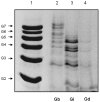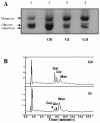Glycoinositolphospholipids from Leishmania braziliensis and L. infantum: modulation of innate immune system and variations in carbohydrate structure
- PMID: 22389743
- PMCID: PMC3289616
- DOI: 10.1371/journal.pntd.0001543
Glycoinositolphospholipids from Leishmania braziliensis and L. infantum: modulation of innate immune system and variations in carbohydrate structure
Abstract
The essential role of the lipophosphoglycan (LPG) of Leishmania in innate immune response has been extensively reported. However, information about the role of the LPG-related glycoinositolphospholipids (GIPLs) is limited, especially with respect to the New World species of Leishmania. GIPLs are low molecular weight molecules covering the parasite surface and are similar to LPG in sharing a common lipid backbone and a glycan motif containing up to 7 sugars. Critical aspects of their structure and functions are still obscure in the interaction with the vertebrate host. In this study, we evaluated the role of those molecules in two medically important South American species Leishmania infantum and L. braziliensis, causative agents of visceral (VL) and cutaneous Leishmaniasis (CL), respectively. GIPLs derived from both species did not induce NO or TNF-α production by non-primed murine macrophages. Additionally, primed macrophages from mice (BALB/c, C57BL/6, TLR2-/- and TLR4-/-) exposed to GIPLs from both species, with exception to TNF-α, did not produce any of the cytokines analyzed (IL1-β, IL-2, IL-4, IL-5, IL-10, IL-12p40, IFN-γ) or p38 activation. GIPLs induced the production of TNF-α and NO by C57BL/6 mice, primarily via TLR4. Pre incubation of macrophages with GIPLs reduced significantly the amount of NO and IL-12 in the presence of IFN-γ or lipopolysaccharide (LPS), which was more pronounced with L. braziliensis GIPLs. This inhibition was reversed after PI-specific phospholipase C treatment. A structural analysis of the GIPLs showed that L. infantum has manose rich GIPLs, suggestive of type I and Hybrid GIPLs while L. braziliensis has galactose rich GIPLs, suggestive of Type II GIPLs. In conclusion, there are major differences in the structure and composition of GIPLs from L. braziliensis and L. infantum. Also, GIPLs are important inhibitory molecules during the interaction with macrophages.
Conflict of interest statement
The authors have declared that no competing interests exist.
Figures









Similar articles
-
Two biochemically distinct lipophosphoglycans from Leishmania braziliensis and Leishmania infantum trigger different innate immune responses in murine macrophages.Parasit Vectors. 2013 Mar 7;6:54. doi: 10.1186/1756-3305-6-54. Parasit Vectors. 2013. PMID: 23497381 Free PMC article.
-
Intraspecies Polymorphisms in the Lipophosphoglycan of L. braziliensis Differentially Modulate Macrophage Activation via TLR4.Front Cell Infect Microbiol. 2019 Jul 10;9:240. doi: 10.3389/fcimb.2019.00240. eCollection 2019. Front Cell Infect Microbiol. 2019. PMID: 31355149 Free PMC article.
-
Differential modulation of macrophage response elicited by glycoinositolphospholipids and lipophosphoglycan from Leishmania (Viannia) shawi.Parasitol Int. 2015 Aug;64(4):32-5. doi: 10.1016/j.parint.2015.01.006. Epub 2015 Jan 22. Parasitol Int. 2015. PMID: 25619843
-
Glycoconjugates in New World species of Leishmania: polymorphisms in lipophosphoglycan and glycoinositolphospholipids and interaction with hosts.Biochim Biophys Acta. 2012 Sep;1820(9):1354-65. doi: 10.1016/j.bbagen.2011.11.001. Epub 2011 Nov 7. Biochim Biophys Acta. 2012. PMID: 22093608 Review.
-
Developmentally regulated changes in the cell surface architecture of Leishmania parasites.Behring Inst Mitt. 1997 Mar;(99):34-43. Behring Inst Mitt. 1997. PMID: 9303200 Review.
Cited by
-
Lipophosphoglycans from Leishmania amazonensis Strains Display Immunomodulatory Properties via TLR4 and Do Not Affect Sand Fly Infection.PLoS Negl Trop Dis. 2016 Aug 10;10(8):e0004848. doi: 10.1371/journal.pntd.0004848. eCollection 2016 Aug. PLoS Negl Trop Dis. 2016. PMID: 27508930 Free PMC article.
-
Overview of the role of kinetoplastid surface carbohydrates in infection and host cell invasion: prospects for therapeutic intervention.Parasitology. 2019 Dec;146(14):1743-1754. doi: 10.1017/S0031182019001355. Epub 2019 Oct 11. Parasitology. 2019. PMID: 31603063 Free PMC article. Review.
-
A defective TLR4 signaling for IFN-β expression is responsible for the innately lower ability of BALB/c macrophages to produce NO in response to LPS as compared to C57BL/6.PLoS One. 2014 Jun 9;9(6):e98913. doi: 10.1371/journal.pone.0098913. eCollection 2014. PLoS One. 2014. PMID: 24911280 Free PMC article.
-
Distinct Macrophage Fates after in vitro Infection with Different Species of Leishmania: Induction of Apoptosis by Leishmania (Leishmania) amazonensis, but Not by Leishmania (Viannia) guyanensis.PLoS One. 2015 Oct 29;10(10):e0141196. doi: 10.1371/journal.pone.0141196. eCollection 2015. PLoS One. 2015. PMID: 26513474 Free PMC article.
-
Toll-Like Receptor 2 Is Required for Inflammatory Process Development during Leishmania infantum Infection.Front Microbiol. 2017 Feb 23;8:262. doi: 10.3389/fmicb.2017.00262. eCollection 2017. Front Microbiol. 2017. PMID: 28280488 Free PMC article.
References
-
- Grimaldi G, Jr, Tesh RB, McMahon-Pratt D. A review of the geographic distribution and epidemiology of leishmaniasis in the New World. Am J Trop Med Hyg. 1989;41:687–725. - PubMed
-
- Herwaldt BL. Leishmaniasis. Lancet. 1999;354:1191–1199. - PubMed
-
- Sacks D, Kamhawi S. Molecular aspects of parasite-vector and vector-host interactions in leishmaniasis. Annu Rev Microbiol. 2001;55:453–483. - PubMed
-
- Evans TG, Thai L, Granger DL, Hibbs JB., Jr Effect of in vivo inhibition of nitric oxide production in murine leishmaniasis. J Immunol. 1993;151:907–915. - PubMed
Publication types
MeSH terms
Substances
Grants and funding
LinkOut - more resources
Full Text Sources
Research Materials
Miscellaneous

